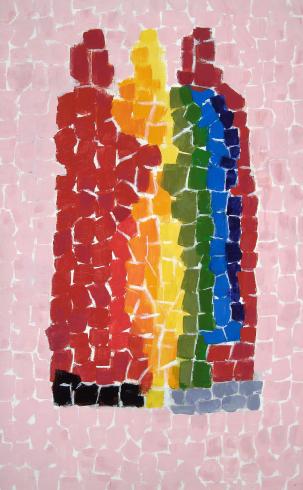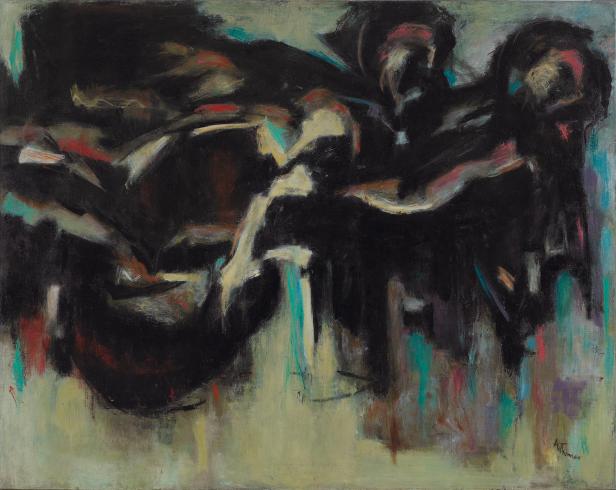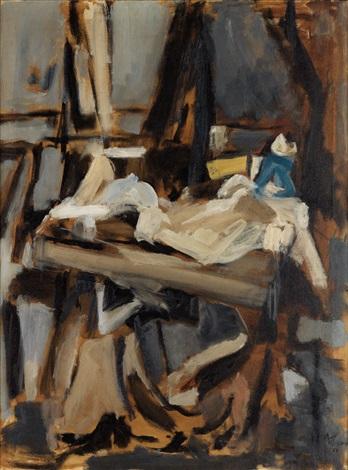Alma Thomas and Expressionism

Part 1: A Close Look at the Art of Alma Thomas
- Have students look at Alma Thomas’s painting In the Studio. Don’t give them any background information for now; just show them the painting.
- Nouns and Adjectives
- Provide each student with 10 post-it notes. On 5 of the notes, they should write 10 nouns to describe the painting, and 5 adjectives on the other 5 notes.
- In groups or as a whole class, place the notes on a Board or wall in the classroom. Have students work together to group words that are similar together.
- Ask students:
- Where do we see commonalities in the nouns and adjectives that we came up with for this painting?
- Where do we see differences in the nouns and adjectives that we came up with for this painting?
- What did you feel when looking at this painting?
- Share with students that today they will learn about Alma Thomas, a Black artist and teacher from Washington, DC. Specifically, they will learn more about her work as an expressionist artist.
Part 2: What is Expressionism?
Explore:
- Have students complete the Expressionism Art Detective Worksheet.
- As a whole class, discuss the responses to the questions, specifically the following question:
- What do you think might be some characteristics of expressionist art based on what you studied in the paintings?
- Jot student responses on chart paper. You’ll refer back to this later on in the lesson.
A Deeper Dive:
- Have students watch this short video about Expressionism. As they’re watching, they should answer the questions on the What is Expressionism? guide.
- SYNTHESIZE: Teachers should address a few points in the video before/after watching:
- The cartoon opens with Pollock smoking a cigarette. Smoking was common during the 1950s, but we know today that smoking causes significant long-term health issues.
- This video has a specific definition of art. In the What is Expressionism? Guide, each student will have the opportunity to think about whether or not they agree with the definition and explain why.
- This video does not discuss the contributions of women to the Expressionist movement. You can share this exhibition and video to give students more context as to why women are frequently not included in mainstream understandings of Abstract Expressionists and why this is problematic.
- Ask students if they can think of other examples today or in history when women are left out of mainstream understandings, even when they made significant contributions?
- Note: You may need to define mainstream—the perceived dominant trends, ideas, and attitudes.
- SYNTHESIZE: Teachers should address a few points in the video before/after watching:
- Have students share responses to the questions on the What is Expressionism? guide as a part of a whole class discussion.
- Ask students how this video contributed to, changed, or supported the characteristics of expressionist art that they identified earlier (refer back to the responses written on the chart paper).
- In partners, students will look more closely at Alma Thomas’s abstract art by studying the artwork on the Alma Thomas’s Expressionist Art Guide and answering the questions.
- As a whole class, discuss responses to the questions on Alma Thomas’s Expressionist Art guide. In addition, discuss:
- How does Alma Thomas’s work contribute to your understanding of expressionist art?
- What makes her art unique?
Part 3: Paint Like an Expressionist
- Have students write down 5 emotions they have felt today on pieces of paper. Have them fold the papers in half and then pick one at random.
- After choosing an emotion, students should consider:
- What colors will best express that emotion?
- What kinds of lines best express that emotion?
- How do you want to move your brush (or marker, or crayon) across the paper to express that emotion?
- What risks do you want to take?
- Have students express themselves!
- Create a gallery walk.
- As each student looks at each artwork, have them write one noun or adjective that they feel captures the piece and place it in front of the artwork.
- Once the gallery walk is complete, have the artist choose the one noun and the one adjective that they feel best captures what they tried to convey. That will become the title of their artwork!
Additional Context
Lesson Context
Alma Thomas was a Black artist and teacher from Washington, DC. Thomas was a complex artist, drawing from many overlapping creative spaces in her life: interior design, puppetry, theatrical performance, and the fine arts. Regardless of the creative space she took up at any given time, Thomas strove for one thing: the search for beauty. And she found it in nature, human ingenuity, and the world around her.
Thomas is often associated with the Washington Color School, a 1950s-1970s art movement in response to Abstract Expressionism; the artists used bold colors to form simple, flat shapes, stripes, and fields of color, rather than focusing on emotion, gesture, and movement. Thomas differed from many other Washington Color School artists, whose works did not reference any objects from real life; instead, her works combined the bold colors and shapes from the Washington Color School with the emotion and dynamism of the Abstract Expressionists.
Key Terms
Expressionism: Expressionism was an artistic movement that emerged in the early 1900s in Germany. This movement pushed forward the idea that art could be an expression of the artist’s internal or emotional state, rather than a representation of the real world.
Representational art: Artwork that clearly depicts real objects. The artist represents something that is real and the audience is able to easily recognize the objects or figures in the artwork.
Washington Color School: A 1950s-1970s art movement in response to Abstract Expressionism; the artists used bold colors to form simple, flat shapes, stripes, and fields of color, rather than focusing on emotion, gesture, and movement.


